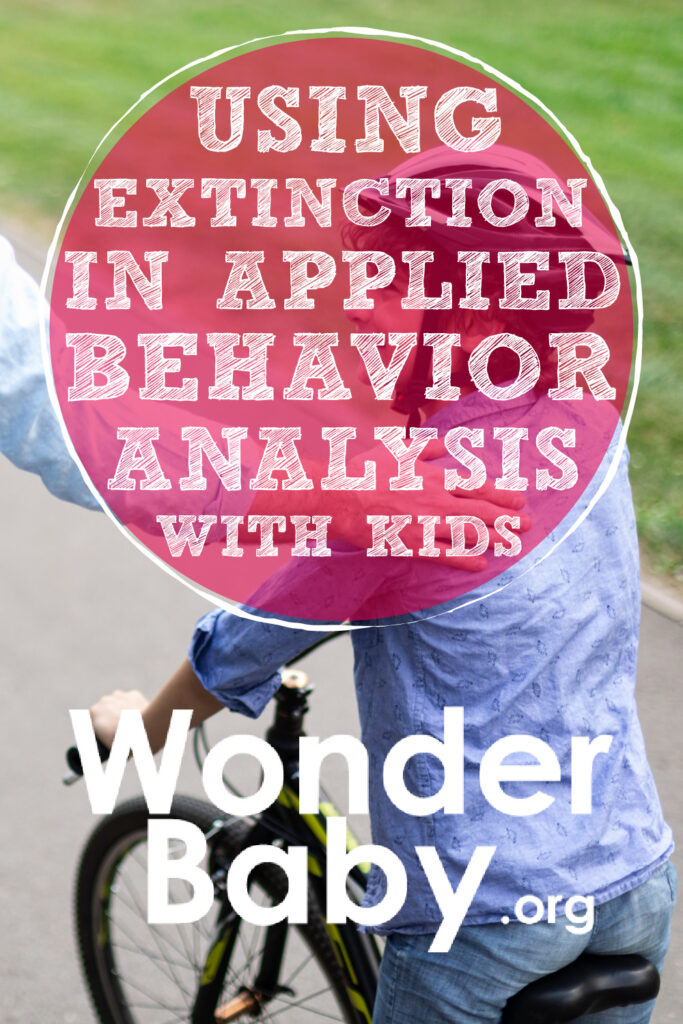Using Extinction in Applied Behavior Analysis with Kids

- Extinction in ABA occurs when an unwanted behavior is eliminated by removing the reward or reinforcement.
- The first step in beginning an extinction approach is identifying what reinforces the unwanted behavior.
- Consistency is key, as is providing positive reinforcements for wanted replacement behaviors.
My phone began to ring. My son’s school was on the caller ID.
“Hello?” I answered trepidatiously.
I knew my neurodivergent son struggled to keep his lips off other kids. He liked how soft skin felt on his lips, but understandably, this made other people uncomfortable.
At home, we had been wrestling with how to approach the situation. On the phone call with his teacher, she and I discussed a plan to eliminate the behaviors reinforcing the undesirable behavior while strengthening his ability to control his body.
It took a couple of weeks of experimentation and persistence, but after using the extinction method and positive reinforcement, my son’s undesirable behavior, kissing other kids, was eliminated.
If you have ever struggled to manage a problem behavior with your young, neurodivergent, or autistic child, you know how challenging it can be to correct it. Figuring out what disciplinary approach to take and how to remain consistent is difficult for every parent.
While not the best option for every inappropriate behavior, the extinction process in Applied Behavior Analysis (ABA) can help eliminate or significantly reduce problem behaviors.
Extinction in ABA: What You Need to Know

Extinction in ABA occurs when a behavior is eliminated by removing the reinforcement. It is primarily used to help remove behaviors that caretakers or clinicians have identified as interfering with a child’s success or growth.
Extinction aims to slowly eliminate unwanted behaviors by deliberately not reinforcing the undesirable behavior and consistently reinforcing the replacement behaviors.
For example, let’s say your child is pinching another child in class during story time, and classroom staff have deduced that she is using pinching to get the teacher’s attention.
To initiate the extinction procedure, when the pinching occurs, the teacher would provide no eye contact or verbal discussion and not directly address your child. Instead, your child would be removed from the other children for their safety.
This process would occur every time your child pinches. However, much positive attention would be given if she could sit through the lesson without pinching.
Identifying the Reinforcing Behavior

Eliminating the reinforcement of negative behaviors is the first step in the extinction procedure. Identifying all reinforcing behaviors is critical to the success of the extinction method.
Reinforcing behaviors are sometimes obvious; other times, they can be challenging to determine. Some examples of reinforcing caregiver behavior include:
- Eye contact
- Attention is re-directed to the child
- Providing a toy/tablet/snack to distract the child from the unwanted behavior
- Change of activity to appease the child
It is important to note that the extinction process is not about ignoring unwanted or attention-seeking behavior. It is about eliminating the reinforcing behavior. Sometimes that reinforcing behavior may be attention, but it can also be many other things.
Extinction requires reducing the reinforcers to where there are absolutely no more left. This can take time, which means, as the team at ABA Connect11. ABA Connect. ABA Terms: Extinction. abaconnect.com. 2017. https://www.abaconnect.com/aba-terms/extinction point out, the unwanted behavior can get worse before it gets better.
Positive Reinforcement
The second step to the success of the elimination procedure is to provide positive reinforcement for the replacement behavior. When your child learns how good it feels to receive positive attention, she will want to do what she can to keep it up!
Reinforcement must be personalized and provided swiftly22. Browne, C.. ABA: What is Reinforcement?. beamaba.com. https://beamaba.com/aba-what-is-reinforcement to be effective. If your reinforcer isn’t given to the child immediately after the replacement behavior, they are unlikely to make the connection. Consistency is key!
Positive reinforcement is sometimes confused with “rewarding.” Although, at times, offering a reward may be helpful, it is crucial to understand that positive reinforcement is so much more.
Some useful positive reinforcement options include:
- High five
- Pat on the back
- Using encouraging words like, “I saw that you kept your hands to yourself. Thank you for doing that! You are so responsible!” or “You have shown wonderful self-control today!”
- Dance party/celebration
- Sticker
- Allowing your child to choose where to sit or who to sit by
- Extra screen time or time with favorite toy/game
- Choice of song or genre of music
What Behaviors Can Be Stopped by Extinction?

Research shows extinction can stop many undesirable behaviors33. Thompson RH, Iwata BA, Hanley GP, Dozier CL, Samaha AL.. The effects of extinction, noncontingent reinforcement and differential reinforcement of other behavior as control procedures. Journal of Applied Behavior Analysis. 2003;36(2), 221-38. https://doi.org/10.1901/jaba.2003.36-221, such as unwanted social behaviors and eating concerns.
Many teachers and parents seek behavioral intervention for problem behaviors that interrupt the flow of class or home life. When a child’s behavior, perhaps from a sensory meltdown or communication difficulty, becomes disruptive to other students or interferes with their siblings’ sleep, caregivers become desperate for help.
That’s when an ABA practitioner becomes involved. The practitioner will determine if the behavior can be treated through extinction. Once the appropriate treatment is selected, an intervention plan can be created.
Some of the behaviors deemed appropriate for the extinction procedure include:
- Mild to moderate aggressive behaviors
- Communication problems, such as yelling, name calling, or tantrums
- Problematic sleeping or eating behaviors
- Distracting repetitive behaviors
- Unacceptable social behaviors, such as unwanted touching of others or inappropriate comments
Extinction is not recommended for the elimination of very aggressive or self-injurious behaviors.
What Are the Possible Drawbacks of Extinction Procedures?
Although the extinction method is helpful in many ways, it’s important to note that there are some possible side effects:
- Increased unwanted behavior (these are often called “extinction bursts”)
- Spontaneous recovery of unwanted behavior when the behavior returns despite closely following the treatment plan
- Desirable behaviors ceasing due to accidentally being ignored
Extinction Bursts
Extinction bursts occur when the target behavior temporarily increases in frequency or intensity for a brief period. These “bursts” are not exclusive to ABA therapy or even neurodivergent individuals. We can see examples of these burts of behvior in many every day experiences.
For example, imagine that you often go to a candy store to buy delicious chocolate candy bars. Pulling on the door handle (the behavior) and entering the store usually results in a mouthful of yummy chocolate (the reward or reinforcer). But one day the store owner changes the door so that you now have to push to open it rather than pull.
Your immediate response to the door not opening may be frustration. You are used to walking up to the door and pulling the handle forcefully to gain access to the candy bars inside the store. This behavior provided a strong history of reinforcement.
However, when the situation changes, and the door no longer opens, the reaction is to shake the door more intensely and with more force. This door shaking is the beginning of the extinction burst.
Since the open door usually delivers a candy bar and it is no longer doing that, more door shaking occurs out of frustration. If the door shaking continues, but the door still does not open, then eventually, the shaking will cease. This results in the extinction of the door-shaking behavior due to not having a reinforcer (the candy bar).
Creating an extinction burst safety plan is essential when applying the extinction procedure because it is a prevalent side effect. With an appropriate safety plan, though, it can be managed appropriately and not interfere with success.
ABA practitioners agree that the extinction method should not be used44. Shira. Extinction. howtoaba.com. 2019. https://howtoaba.com/extinction on self-harming or aggressive behaviors, as the side effects are too risky. Talk with your ABA practitioners about a more appropriate plan for these behaviors.
What to Expect During Extinction Procedures

When an extinction plan is followed closely, it will eliminate negative behaviors in a short amount of time. It is essential to be prepared for what to expect during the process to avoid being thrown off course.
After the practitioner has created the intervention plan, implementation can begin. Withholding reinforcement to the problem behavior, such as pinching, will most likely cause your child to feel upset or confused.
It is helpful to have a calming or soothing activity planned in preparation for this disturbance. Plan one for yourself, too. Remaining calm is critical.
Continue with the plan as identified by your ABA practitioner as consistently as possible. The faster the reinforced behaviors decrease, the quicker you will reach the extinction point. If the pinching gets reinforced accidentally, just take note of it and return to the plan.
Next time it occurs, ignore the pinching and remove her from the activity in which she pinched.
Anticipate an extinction burst and follow the safety plan that has been created for you.
The best part of this process is that you get to provide your child with reinforcement for positive behavior every time she succeeds. She made it through story time without pinching! Now she gets a dance party and can choose the next storytime book.
The feeling of success will be her motivator to cease the pinching and participate in storytime instead.
References
- ABA Connect. (2017, December 9). ABA Terms: Extinction. abaconnect.com. https://www.abaconnect.com/aba-terms/extinction/
- Browne, C. (n.d.) ABA: What is Reinforcement? beamaba.com. https://beamaba.com/aba-what-is-reinforcement/
- Thompson RH, Iwata BA, Hanley GP, Dozier CL, Samaha AL. (2003) The effects of extinction, noncontingent reinforcement and differential reinforcement of other behavior as control procedures. Journal of Applied Behavior Analysis, 36(2), 221-38. https://doi.org/10.1901/jaba.2003.36-221
- Shira. (2019, December 4). Extinction. howtoaba.com. https://howtoaba.com/extinction/

Related Posts

Special Needs
5 Spring Cleaning Tips for Families of Children with Disabilities
Spring cleaning is an opportunity to create a more accessible, organized, and supportive space for your child with disabilities. Declutter, deep clean, and refresh!

Visual Impairment
The Gift of Understanding: How a Young Child Helps His Blind Father Navigate Life
When a parent is blind, it’s natural for people to wonder how their sighted child will adapt. Will they struggle to understand their parent’s needs? Will they feel burdened by...

Assistive Technology, Support
May We Help: Engineering Independence for People with Disabilities
May We Help is dedicated to designing and building custom solutions that help individuals of all ages achieve mobility, access, and independence, all at no cost.